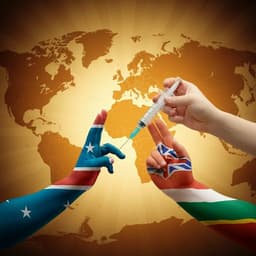
Medicine and Health
COVID-19 in Latin America: A Snapshot in Time and the Road Ahead
J. L. Omar, E. María, et al.
This review, conducted by a team of experts including Jorge Larotta Omar and others, delves into the epidemiology of COVID-19 in Latin America. It explores initial public health responses, vaccination strategies, and the factors influencing variations in outcomes across the region. Discover the successes, challenges, and critical lessons for future preparedness.
~3 min • Beginner • English
Introduction
The paper reviews the disproportionate impact of COVID-19 in Latin America and the Caribbean, a region accounting for roughly a quarter of global SARS‑CoV‑2 infections. Initially affecting older adults, the pandemic’s burden increasingly involved children and adolescents, who also suffered indirect harms such as school closures and disruptions in social-emotional development. The review aims to synthesize epidemiology, initial public health measures, vaccination strategies, and lessons learned across Latin America to identify successes, challenges, and considerations for future preparedness. Heterogeneity in outcomes across countries is attributed to differences in healthcare infrastructure, political leadership, poverty and inequality, testing capacity, and vaccine access.
Literature Review
The narrative review synthesizes published data and surveillance reports up to late 2022 on: (1) emergence of COVID-19 in the region (first cases in Brazil and Chile; early importations from Europe); (2) regional epidemiology, including case and mortality dynamics, excess deaths (e.g., Ecuador), and the severe second wave in 2021 (notably Brazil, Peru); (3) pediatric impacts including MIS‑C with higher ICU admission and mortality than some other regions; (4) circulating variants—Gamma (Brazil), Lambda (Peru), Mu (Colombia), local lineages (Costa Rica), and the later dominance of Delta and Omicron—alongside evolving genomic surveillance capacity under PAHO’s regional network; (5) risk factors and comorbidities associated with severe outcomes (diabetes, obesity, COPD, CKD, cardiovascular disease, immunosuppression), and socioeconomic determinants (lower SES, crowding, limited adherence to mitigation measures); (6) seroprevalence estimates in 2020 (0.2–70%, pooled ~25–35%), asymptomatic infections (~30%), waning immunity and reinfections (e.g., Manaus despite ~76% attack rate); (7) public health measures (mask mandates, lockdowns, telework, healthcare capacity expansion, telemedicine, and case identification/testing improvements—especially in Chile and Costa Rica); (8) vaccination authorizations, procurement (COVAX, bilateral deals, donations, PAHO Revolving Fund), prioritization strategies, rollout speeds, pediatric vaccination expansion, and booster strategies including heterologous schedules; (9) vaccine efficacy/effectiveness from clinical trials and observational studies in Argentina, Brazil, Chile, Colombia, Cuba, and others; (10) lessons for surveillance, vaccination strategy, local manufacturing, combating hesitancy, and sustaining other health services (routine immunization, cancer care).
Methodology
This is a narrative review based on previously conducted studies and publicly available data; no new human or animal research was performed by the authors. Sources include peer‑reviewed literature, surveillance dashboards (WHO, PAHO, Our World in Data), ministry of health reports from multiple Latin American countries, and institutional publications. The review organizes evidence into thematic sections: emergence, epidemiology, variants, risk factors, seroprevalence, public health responses, vaccination (authorizations, uptake, pediatric programs, boosters), vaccine trial and real‑world effectiveness data from the region, and cross‑cutting lessons for surveillance, health systems, and vaccination policy. Data currency in figures/tables is provided (e.g., up to September/October 2022).
Key Findings
- Latin America accounted for a substantial share of global SARS‑CoV‑2 infections and deaths, with marked heterogeneity by country.
- Case fatality rates among countries with ≥300,000 cases ranged from ~0.8% (Cuba) to 6.2% (Peru). Pediatric cases remained a smaller proportion (e.g., 12.5% in Chile through Oct 2021), but hospitalizations and deaths occurred; deaths among 0–19-year-olds ranged from 0% (Argentina, Chile, Costa Rica, Cuba, Honduras) to 9.1% (Haiti).
- Excess mortality exposed under-detection; Ecuador saw a 64% rise in all-cause mortality in 2020, with confirmed COVID-19 deaths representing only ~21% of excess deaths.
- The 2021 second wave was severe (e.g., Manaus, Brazil), and Peru recorded extremely high excess deaths per million by early 2021. Omicron led to sharp case surges late 2021–early 2022; doubling times for cases were 1.7–5.6 days in some countries.
- MIS‑C had significant impact, with higher pediatric ICU admission and mortality rates reported than in some other regions and frequent antibiotic use.
- Variants first identified in the region included Gamma (Brazil), Lambda (Peru), and Mu (Colombia). Genomic surveillance capacity improved via PAHO’s regional network to 33 laboratories.
- Risk factors for severe outcomes included diabetes, obesity, COPD, CKD, cardiovascular disease, immunosuppression, neurologic disease, and socioeconomic determinants (lower SES, crowding, limited ability to comply with lockdowns). Life expectancy decreased notably in 2020: Peru (~8 years), Bolivia/Ecuador (~6 years), with ongoing declines in some countries in 2021.
- Seroprevalence (2020) varied widely (0.2–70%; pooled ~25–35%). Despite high attack rates (e.g., Manaus ~76% by Oct 2020), reinfections occurred, likely due to waning immunity and poor infection control.
- Public health responses included mask mandates, lockdowns, expanded hospital/ICU capacity, field hospitals, telemedicine, and enhanced testing (Chile achieved some of the highest testing rates; Costa Rica provided free tests).
- Vaccination: Early EUA in Mexico for BNT162b2; procurement via COVAX, bilateral deals, donations, PAHO Revolving Fund. By Sep 2022, many countries were below the 68% global average for at least one dose; booster coverage ranged from 0% (Nicaragua) to 81.4% (Chile). Pediatric vaccination extended to ages 2–11 in several countries; heterologous booster strategies were common.
- Vaccine performance (selected): BNT162b2 efficacy ~95% overall; Argentina 97.2%, Brazil 87.7%; ~91.3% at 6 months overall; third dose ~95.3% overall and 100% in the Brazil subset (trial). ChAdOx1 pooled efficacy ~70.4% (Brazil ~64.2% with standard dosing). CoronaVac effectiveness in Chile: 65.9% (symptomatic), 87.5% (hospitalization), 90.3% (ICU), 86.3% (death); in Brazilian ≥70-year-olds during Gamma wave: 47% (symptomatic), 56% (hospitalization), 61% (death). In Colombia (≥60 years), overall VE: 69.9% (hospitalization without death), 79.4% (death after hospitalization), 74.5% (death without hospitalization). Heterologous boosting after Sinovac primary series improved protection (e.g., to ~90–93% for infection/hospitalization with BNT162b2/ChAdOx1 boosters in Chilean data).
- Neutralization: Several vaccines showed 3–5‑fold reduced neutralization vs Gamma; two BNT162b2 doses showed reduced activity vs Omicron, with a third dose restoring neutralization to near wild‑type two‑dose levels.
- COVID‑19 disrupted routine health services (childhood immunization declines, reduced cancer care) and prolonged school closures, with anticipated downstream health and social consequences.
- Regional and global organizations (PAHO, World Bank, UNICEF) supported surveillance, procurement, and vaccine manufacturing initiatives.
Discussion
Findings underscore that Latin America’s pandemic experience was shaped by preexisting inequities, variable governance, and health system capacity. Countries with strong, coordinated mitigation measures, testing, and healthcare resourcing managed transmission and outcomes more effectively. The rapid emergence and spread of variants highlighted the necessity of robust genomic surveillance, which has improved through regional networks. Vaccination remains central to reducing severe disease and mortality; however, uneven rollout, supply constraints, cold-chain logistics, and vaccine hesitancy limited progress in some settings. Evidence from regional trials and real-world studies confirms meaningful effectiveness of multiple vaccine platforms, including in the presence of VOCs, and supports booster and heterologous strategies. Sustained attention to routine health services and education is critical to mitigate collateral harms. The review’s synthesis informs policies on surveillance strengthening, equitable vaccine allocation, local manufacturing to reduce dependence on external supply, targeted outreach to high-risk and marginalized groups, and communication strategies to build public trust and counter misinformation.
Conclusion
COVID‑19 imposed a heavy public health burden across Latin America, with heterogeneous outcomes across countries. Vaccination, along with surveillance and broader public health interventions, is the consistent pillar of successful response and future preparedness. The region has expanded pediatric vaccination, implemented boosters (including heterologous schedules), and pursued local manufacturing partnerships to improve supply. Continued investments in genomic and epidemiologic surveillance, health system capacity, equitable vaccine access (including cold-chain solutions), and public engagement to address hesitancy are essential. Future research should focus on real-world vaccine effectiveness across variants and subpopulations, optimization of booster strategies and coadministration, evaluation of long-term pandemic impacts on routine health services and education, and operational innovations to strengthen regional manufacturing and supply chains.
Limitations
- Narrative (non-systematic) review relying on previously published studies and public data; potential selection bias and incomplete capture of all relevant sources.
- Rapidly evolving epidemiology and variant landscape; figures and vaccination statistics reflect time-bounded snapshots (often through September–October 2022) and may have changed subsequently.
- Under-ascertainment and variability in testing and reporting across countries (e.g., excess mortality far exceeding confirmed COVID-19 deaths) limit comparability and may bias estimates of incidence, CFR, and vaccine impact.
- Early limitations in genomic surveillance in several countries constrained variant tracking and attribution of outcomes to specific lineages.
- Heterogeneity in study designs, populations, and circulating variants complicates cross-study comparisons of vaccine effectiveness.
Related Publications
Explore these studies to deepen your understanding of the subject.







